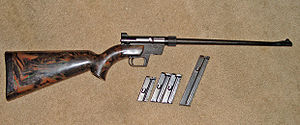AR-7
| AR-7 | |
|---|---|

Armalite AR-7 survival rifle with 8-, 10-, and 15-round magazines.
|
|
| Type | Survival rifle |
| Place of origin | United States |
| Service history | |
| In service | 1959–Present |
| Production history | |
| Designer | Eugene Stoner |
| Designed | 1958 |
| Variants | Armalite AR-7 Explorer; Charter Arms AR-7 Explorer; Charter Arms Explorer II Pistol; Israeli Pilot's Survival Rifle; Henry U.S. Survival .22 |
| Specifications | |
| Weight | 1.13 kg |
| Length | 889 mm |
| Barrel length | 406 mm |
|
|
|
| Cartridge | .22 Long Rifle |
| Action | Straight blowback-operated |
| Rate of fire | Semi-automatic |
| Muzzle velocity | 1,080 ft/s (329 m/s) to 1,280 ft/s (390 m/s) (varies by type of .22 LR cartridge) |
| Effective firing range | 100 m |
| Feed system | Standard 8-round magazine. 10-, 15-, 25-round magazines available. |
| Sights | Aperture rear and drift-adjustable front. |
The ArmaLite AR-7 Explorer is a semi-automatic firearm in .22 Long Rifle caliber developed from the AR-5 that was adopted by the U.S. Air Force as a pilot and aircrew survival weapon. The AR-7 was adopted and modified by the Israeli Air Force as an aircrew survival weapon.
The AR-7 was designed by American firearms designer Eugene Stoner, who is most associated with the development of the AR-15 rifle that was adopted by the US military as the M16. The civilian AR-7's intended markets today are backpackers and other recreational users as a takedown utility rifle. The AR-7 is often recommended for use by outdoor users of recreational vehicles (automobile, airplane or boat) who might have need for a weapon for foraging or defense in a wilderness emergency.
The prototype of what would become the AR-7 was designed by Eugene Stoner at ArmaLite Inc., a division of Fairchild Aircraft. The rifle shares some of the features of the bolt-action AR-5, another rifle designed by Stoner for ArmaLite and adopted by the United States Air Force in 1956 as the MA-1. The MA-1 was intended to replace the M4 Survival Rifle and the M6 Aircrew Survival Weapon which was a superimposed ("over-under") twin-barrel rifle/shotgun chambered in .22 Hornet and .410 bore, using a break-open action. The AR-5 had the advantage of repeat fire over the then-standard M6, using the same .22 Hornet cartridge. When the AR-5 was adopted as the MA-1 but was not placed in issue due to the numbers of usable M4 and M6 survival weapons in USAF inventory, ArmaLite used the research and tooling for the AR-5 in developing the AR-7 for the civilian market.
The AR-7 uses a blowback semi-automatic action in .22 Long Rifle but retains the AR-5/MA-1 feature of storing the disassembled parts within the hollow stock, which is filled with plastic foam and capable of floating. Like the bolt-action AR-5, the AR-7 was designed as a survival rifle for foraging small game for food. The AR-7 is constructed primarily of aluminum, with plastic for the stock, buttcap, and recoil spring guide. The bolt is steel. The original barrel was aluminum using a rifled steel liner; barrels of some production models have used all steel barrels, others have used barrels made of composite materials. The AR-7 measures 35 inches overall when assembled. It disassembles to four sections (barrel, action, , and magazine), with three parts storing inside the plastic stock, measuring 16 inches long. The rifle weighs 2.5 pounds, light enough for convenient backpacking. The rear sight is a peep sight, which comes on a flat metal blade with an aperture (in later production two different size apertures available by removing and flipping the rear sight), and is adjustable for elevation (up-down). The front sight is adjustable for windage (side-to-side). Accuracy is sufficient for hunting small game at ranges to 50 yards.
...
Wikipedia
